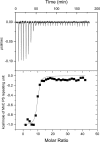Thermodynamics and density of binding of a panel of antibodies to high-molecular-weight capsular polysaccharides
- PMID: 19005020
- PMCID: PMC2620655
- DOI: 10.1128/CVI.00290-08
Thermodynamics and density of binding of a panel of antibodies to high-molecular-weight capsular polysaccharides
Abstract
The interaction between antipolysaccharide (anti-PS) antibodies and their antigens was investigated by the use of isothermal titration calorimetry to determine the thermodynamic binding constant (K), the change in the enthalpy of binding (DeltaH), and the binding density (N) to high-molecular-weight PSs. From these values, the change in the entropy of binding (DeltaS) was calculated. The thermodynamic parameters of binding to high-molecular-weight capsular PSs are reported for two monoclonal antibodies (MAbs) with different specificities for meningococcal serogroup C PS, five MAbs specific for different pneumococcal serotypes, and the Fab fragments of two antipneumococcal MAbs. The K values were in the range of 10(6) to 10(7) M(-1), and these values were 1 to 2 orders of magnitude greater than the previously reported K values derived from antibody-oligosaccharide interactions. The DeltaH associated with binding was favorable for each MAb and Fab fragment. The DeltaS associated with binding was also generally favorable for both the MAbs and the Fab fragments, with the exception of the anti-serotype 14 MAb and its Fab fragment. N provides information regarding how densely MAbs or Fabs can bind along PS chains and, as expressed in terms of monosaccharides, was very similar for the seven MAbs, with an average of 12 monosaccharides per bound MAb. The value of N for each Fab was smaller, with five or seven monosaccharides per bound Fab. These results suggest that steric interactions between antibody molecules are a major influence on the values of N of high-affinity MAbs to capsular PSs.
Figures


Similar articles
-
Avidity, potency, and cross-reactivity of monoclonal antibodies to pneumococcal capsular polysaccharide serotype 6B.Infect Immun. 2001 Jan;69(1):336-44. doi: 10.1128/IAI.69.1.336-344.2001. Infect Immun. 2001. PMID: 11119522 Free PMC article.
-
Characterization of Escherichia coli K1 colominic acid-specific murine antibodies that are cross-protective against Neisseria meningitidis groups B, C, and Y.Mol Immunol. 2014 Jun;59(2):142-53. doi: 10.1016/j.molimm.2014.01.016. Epub 2014 Mar 4. Mol Immunol. 2014. PMID: 24603121
-
Titration calorimetry study of an anti-idiotypic antibody cascade in a human melanoma-associated antigen system.Mol Immunol. 1997 Jul;34(10):695-707. doi: 10.1016/s0161-5890(97)00095-3. Mol Immunol. 1997. PMID: 9430197
-
Bacterial capsular polysaccharides--biochemistry, immunity and vaccine.Mol Immunol. 1987 Oct;24(10):1005-19. doi: 10.1016/0161-5890(87)90067-8. Mol Immunol. 1987. PMID: 3119993 Review.
-
[The capsular polysaccharide of serogroup-B meningococci: its immunobiological properties].Zh Mikrobiol Epidemiol Immunobiol. 1999 Sep-Oct;(5):52-6. Zh Mikrobiol Epidemiol Immunobiol. 1999. PMID: 10852023 Review. Russian. No abstract available.
Cited by
-
Multivalent display of minimal Clostridium difficile glycan epitopes mimics antigenic properties of larger glycans.Nat Commun. 2016 Apr 19;7:11224. doi: 10.1038/ncomms11224. Nat Commun. 2016. PMID: 27091615 Free PMC article.
-
IgA and IgG1 Specific to Vi Polysaccharide of Salmonella Typhi Correlate With Protection Status in a Typhoid Fever Controlled Human Infection Model.Front Immunol. 2019 Nov 1;10:2582. doi: 10.3389/fimmu.2019.02582. eCollection 2019. Front Immunol. 2019. PMID: 31781100 Free PMC article. Clinical Trial.
-
Salmonella Typhi Vi capsule prime-boost vaccination induces convergent and functional antibody responses.Sci Immunol. 2021 Oct 29;6(64):eabj1181. doi: 10.1126/sciimmunol.abj1181. Epub 2021 Oct 29. Sci Immunol. 2021. PMID: 34714686 Free PMC article.
-
T cells control the generation of nanomolar-affinity anti-glycan antibodies.J Clin Invest. 2017 Apr 3;127(4):1491-1504. doi: 10.1172/JCI91192. Epub 2017 Mar 13. J Clin Invest. 2017. PMID: 28287405 Free PMC article.
-
Differential idiotype utilization for the in vivo type 14 capsular polysaccharide-specific Ig responses to intact Streptococcus pneumoniae versus a pneumococcal conjugate vaccine.J Immunol. 2012 Jul 15;189(2):575-86. doi: 10.4049/jimmunol.1200599. Epub 2012 Jun 15. J Immunol. 2012. PMID: 22706079 Free PMC article.
References
-
- Adams, E. L., P. A. Kroon, G. Williamson, and V. J. Morris. 2003. Characterization of the heterogeneous arabinoxylans by direct imaging of individual molecules by atomic force microscopy. Carbohydr. Res. 338771-780. - PubMed
-
- Barisas, B. G., S. J. Singer, and J. M. Sturtevant. 1972. Thermodynamics of the binding of 2,4-dinitrophenyl and 2,4,6-trinitrophenyl haptens to the homologous and heterologous rabbit antibodies. Biochemistry 112741-2744. - PubMed
-
- Barisas, B. G., J. M. Sturtevant, and S. J. Singer. 1971. Thermodynamics of the binding of haptens to rabbit anit-2,4-dinitrophenyl antibodies. Biochemistry 102816-2821. - PubMed
-
- Bhat, T. N., G. A. Bentley, G. Boulot, M. I. Greene, D. Tello, W. Dall'Acqua, H. Souchon, F. P. Schwarz, R. A. Mariuzza, and R. J. Poljak. 1994. Bound water molecules and conformational stabilization help mediate an antigen-antibody association. Proc. Natl. Acad. Sci. USA 911089-1093. - PMC - PubMed
-
- Braden, B. C., A. Cauerhff, W. Dall'Acqua, B. A. Fields, F. A. Goldbaum, E. L. Malchiodi, R. A. Mariuzza, R. J. Poljak, F. P. Schwarz, X. Ysern, et al. 1995. Structure and thermodynamics of antigen recognition by antibodies. Ann. N. Y. Acad. Sci. 764315-327. - PubMed
MeSH terms
Substances
LinkOut - more resources
Full Text Sources

